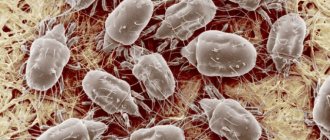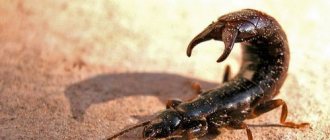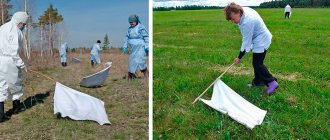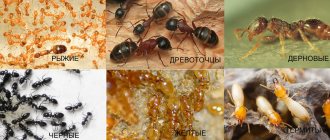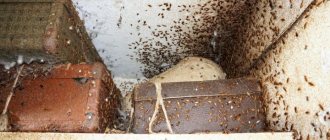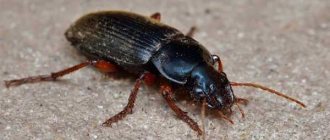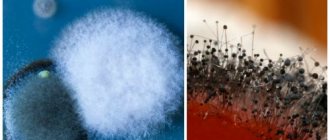Main spawn locations
Most ticks are blood-sucking and prefer to settle closer to humans. The favorite places of these parasites are upholstered furniture, bedding and pillows. You can tell that an unwanted neighbor has appeared in the house by the presence of regular bite marks. Ticks can also be found on window sills, on the leaves of house plants and on pets.
But the vast majority live in dust; the size of such mites is extremely small and beyond the reach of the human eye. But you can find out about the number of uninvited guests by taking a dust sample for analysis to a laboratory. However, no matter what species settles nearby, you should immediately take all possible measures to get rid of ticks, among which there is not a single species that would be considered safe for humans.
Select a tool on the website All tools =>>
Types of house ticks
Several species can simultaneously live in a person’s apartment, each of which has its own location. Some species can be blood-sucking, others feed on dead cells, and still others parasitize houseplants and animals. But there are also more dangerous representatives of this class, which do not just attack a person, but settle on the body, under the skin or in the ears.
Dusty
Dust mites are the most common neighbors of humans and can be found in almost every apartment. This species cannot be noticed by the human eye, but if the parasite population exceeds acceptable standards, this can have an extremely negative impact on health, especially for young children. These mites feel most comfortable at a humidity of 50% and a temperature of 18 to 25 degrees, which is most often room temperature.
The favorite locations of dust mites are books, soft toys, sofas, bedding, carpets and absolutely any surface on which a large amount of dust accumulates.
Such parasites feed on dead skin cells and do not have direct contact with the human body, which does not make them any less dangerous. The greatest threat is posed by the waste products of the parasite, which accumulate in a person’s home every day. They are one of the most powerful allergens and easily penetrate the respiratory tract. The consequence of a large accumulation of dust mites is allergic rhinitis, asthma, dermatitis, conjunctivitis and even angioedema.
Ixodes
Ticks of this species are one of the largest representatives of the class and are found on absolutely any continent and in any climatic zone. Such parasites are not permanent residents of apartments or houses, but very often get there with the help of pets or on clothing. Parasites are blood-sucking and easily find a future victim. Ixodid ticks are most active from May to September; when returning from a walk during these months, it is necessary to carefully inspect the clothing and fur of your pet. The most terrible consequences are considered to be encephalitis, borrelosis and Lyme disease. If an ixodid tick bite is detected, you should not only remove the parasite, but also take it for analysis to the nearest laboratory.
Select a tool on the website All tools =>>
Arachnoid
If a spider mite has settled in an apartment, the first place to look for it is a windowsill with house plants. This parasite, contrary to the erroneous belief, is not an insect, but an animal and is constantly in search of food. It may appear with a new purchased plant or sneak through an open window. This species attacks the plant quite quickly and easily moves onto healthy flowers. It does not pose any direct harm to humans, but may not destroy all home greens.
Bed
This type of mite is often found in a person’s apartment; it can be found on upholstered furniture, mattresses, bedding and soft toys. The parasite does not exceed 1 mm in size, but it is unlikely that you will be able to miss the appearance of such a neighbor. The peak activity of bed ticks occurs at night; it is in the dark that they are easiest to detect. The parasite is blood-sucking and leaves behind many bites on the body, close to each other. Bed mites are responsible for allergic reactions in humans, rashes, redness of the eyelids and cause bouts of coughing or runny nose without additional symptoms of ARVI.
How to detect
The microscopic size of ticks does not always allow them to be visually detected. If the pest has left a bite on the skin, then, depending on a number of factors, various signs will appear. A pronounced manifestation of an insect bite is observed in people suffering from allergic diseases, as well as in the elderly and children. In other situations, the bite may become painless and not noticed immediately.
The area affected by the pest is characterized by redness and slight swelling of the skin. In the center of the irritated area is a small dark dot left by the insect. If the parasite did not have time to fall off, then part of its small body can be seen over the redness.
Dust mites are absolutely impossible to see. You can suspect their appearance by painful symptoms and skin rashes.
Methods of disposal
It is extremely difficult to get rid of ticks in an apartment due to the wide variety; each individual species requires additional means of extermination and it is not always possible to eliminate unpleasant neighbors the first time. First, you need to decide what type of ticks you have to fight, and then start choosing household chemicals or give preference to folk remedies.
Folk remedies
To effectively get rid of annoying parasites, not only expensive and specialized products can help, but also some improvised products and substances that can be found in almost any apartment. The main difficulty in removing ticks at home is their small size and large area to be treated. But with the help of traditional methods, the risk of poisoning is reduced, especially in the case of apartments where there are small children.
Dust mites . These parasites have to be gotten rid of most often, and the places where they spread occupy almost the entire area of human habitation.
,To prevent and get rid of such a neighborhood, it is recommended to use the following means:
- Salt and soda. It is necessary to add these products when washing floors or wiping dust; just 1 tablespoon of each product is enough for 10 liters of water. Do not increase the amount of the substance to avoid the appearance of a white coating on the floor and furniture. It is recommended to use this method at least once a week.
- Essential oils. Ticks have an extremely negative attitude toward most essential oils with strong, rich odors: lavender, rosemary, eucalyptus, geranium, orange, grapefruit, and so on. For 10 liters of water you need an absolutely large amount, no more than 5 drops.
- Natural flowers. By analogy with essential oils, dust mites are repelled by many indoor plants or fresh flowers. It is recommended to grow geraniums and place small bouquets or sachets of mint, lavender or chamomile in the most vulnerable places. This product has its effect only during the period when it is capable of emitting an odor; if necessary, the sachet should be changed.
When fighting dust mites, these folk remedies are the most effective, but they will not save the entire situation without regular cleaning of the apartment, changing of linen, constant dusting and humidification of the room.
IMPORTANT:
When fighting ticks, cleaning alone is usually not enough; it is also necessary to thoroughly treat the furniture, wash clothes and bedding, followed by ironing at high temperatures or steaming.
Ixodid ticks . An encounter with such a parasite not only cannot be called pleasant, but also far from safe. However, in this case, it is recommended not only to use protection methods, but also to follow simple rules: do not go into the forest and main habitats during the period of parasite activity, use clothing that protects the body as much as possible.
ON A NOTE:
To get rid of ticks, there are a number of specialized products, but you should carefully study the instructions for use; a large percentage of purchased formulations cannot be used in rooms where there are people, much less children and pets.
- Peppermint spray. It is very simple to prepare this repellent; you need to add three teaspoons of a small percentage of vinegar to 25 drops of mint essential oil and finally combine with three teaspoons of water. For ease of use, it is recommended to place the resulting product in a small bottle with a spray bottle and use it before walking.
- Carnation. It is not the plant itself that has a deterrent effect, but its inflorescence, which is a spice. A tablespoon of cloves is added to a small container with 250-300 ml of water, the liquid is brought to a boil and infused for 10 hours. The resulting solution can be used to protect the body from tick bites, and can also be used to treat the main cracks and furniture in the apartment.
Spider mite . This species is small, barely noticeable in size, but is capable of destroying not only home flowers, but also the entire crop of people living in their home. The most gentle methods for plants will be traditional methods, which can be used for any type of flower.
- Laundry soap. A solution of this substance gets rid of most known microbes and parasites, and also perfectly protects against spider mites. 200 grams of pre-grated soap are dissolved in a bucket of warm or hot water. It is recommended to leave the resulting solution for several hours and only then treat the affected plants. The leaves are treated with a sponge; you also need to wipe the pot with it and spray the ground. Soap foam should be washed off with cool water after 3-4 hours.
- Ammonia. Treatment with an alcohol solution is also a highly effective way to combat emerging pests. To prepare the solution, combine a bucket of water and 30 ml of alcohol, then treat the leaves and stems with the resulting solution. It is worth acting as quickly as possible, especially on plants with thin leaves.
- Rosemary. To effectively get rid of spider mites, you should dissolve a few drops of rosemary essential oil in a liter of water and wipe the infected areas with the resulting solution.
Physical and mechanical methods
Direct action on ticks is the most effective, and most importantly safe for humans. To get rid of ticks, you need to create unfavorable temperature conditions or significantly change the humidity in the room; there are several ways to get rid of several types of ticks yourself at once:
Steam cleaner. This method is one of the simplest to implement and can cope not only with existing ticks, but also serve as an excellent preventive measure. Regular cleaning and frequent changes of bedding will minimize the reappearance of mites in high concentrations.
Ventilation. This method of fighting ticks is especially relevant in the cold season, which is the least comfortable for the main life processes of ticks. A comfortable temperature for all the most important life processes of a tick is a delta of 18 to 25 degrees. By lowering or raising the temperature, not the most comfortable conditions for the existence of ticks are created, thereby allowing the pest to be eliminated quickly and almost forever. It is also recommended to wash bedding at high temperatures and dry it in frosty air in winter and in direct sunlight in summer.
INFORMATION:
All actions to get rid of ticks must be done from top to bottom; first, baseboards and corners under the ceiling, cornices and chandeliers are treated. Next, wipe the hard surfaces of furniture and doors. Then start processing the batteries and washing the floor. After cleaning, be sure to ventilate the room.
Neighborhood dangers
When it comes to blood-sucking or subcutaneous mites, there is no need to talk about danger; direct contact can cause many diseases, but everything is completely different when it comes to dust mites. Even taking into account regular cleaning, this type of mite is a constant neighbor of a person and becomes dangerous only when the level of dust exceeds 500 units per gram of dust.
In this case, the amount of their waste products significantly exceeds the norm and can cause a number of dangerous diseases, such as asthma, eczema, Quincke's edema, dermatitis, various skin inflammations and allergic reactions. If a rash regularly appears on the body, conjunctivitis does not go away, or allergies are tormented, then in 90% of cases these are the consequences of an undesirable neighborhood with an increased colony of mites, in which case you should definitely consult a dermatologist.
Select a tool on the website All tools =>>
Why are they dangerous?
The main danger of ticks is that they harm human health. Ticks are ectoparasites and causative agents of natural focal diseases. Pests are capable of transmitting various pathogens through the process of sucking blood.
Diseases
The most common diseases carried by ticks are borreliosis, ehrlichiosis and encephalitis. Infections are severe and can cause disability. As a rule, the diseases are chronic in nature and have a long rehabilitation period of up to a year. In addition to the diseases listed above, ticks carry:
- spotted fever;
- tularemia;
- babesiosis;
- tick-borne typhus
The variety of linen mites is not a blood-sucking pest, but these insects are also dangerous to humans. Microscopic excrement of insects along with dust penetrates the lungs and provokes the development of allergic reactions. In combination with a cold, allergies can cause bronchial asthma.
Allergy symptoms
The manifestation of disease symptoms depends on the pathogen that enters the human body after an insect bite. Since pests carry a large number of diseases, each of them is characterized by individual symptoms. In particular:
- Borreliosis is characterized by the appearance of migraines, general fatigue of the body, fever, attacks of nausea and vomiting. The most pronounced sign of the disease is a rash on the skin in the form of a ring-shaped redness.
- Tick-borne encephalitis causes a sharp increase in temperature to 39 degrees. Other symptoms include muscle soreness, vomiting and migraines.
- Ehrlichiosis is characterized by a sudden increase in body temperature and chills, joint pain, and a feeling of malaise. In severe cases, a skin rash appears.
- Symptoms of tick-borne relapsing fever develop gradually over a couple of weeks. Primary signs are insomnia, lack of appetite and feeling weak. Subsequently, the temperature rises, pain in muscles and joints occurs, and a severe rash forms on the skin.
